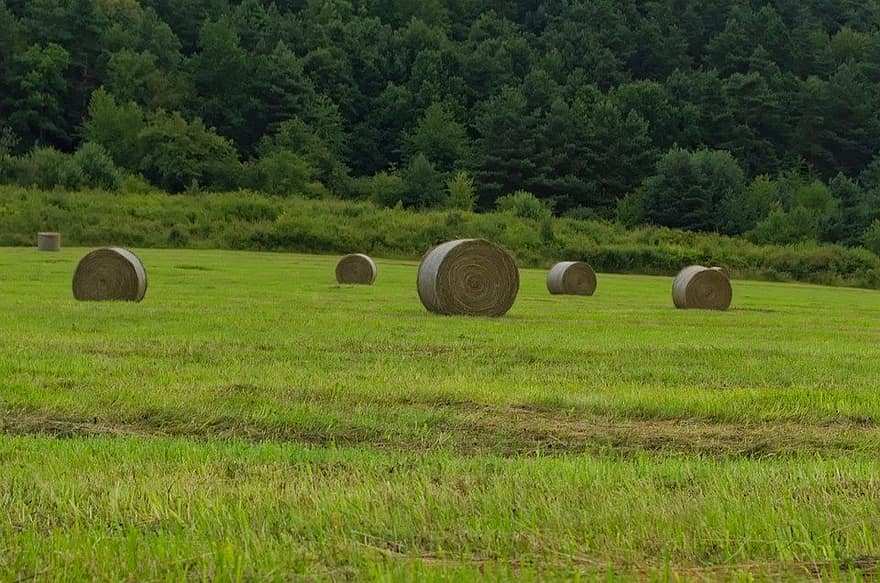The late Alan Nation, longtime editor of ‘The Stockman Grass Farmer’ was fond of encouraging readers to identify any “unfair advantage” they had and to use that advantage to the fullest. Those advantages may be very specific to a particular operation or they may be more regional.
In the Southeast, livestock producers can take advantage of a long growing season and generally abundant precipitation. But even here, where winters are relatively mild and short, meeting feed requirements during the winter represent a major fraction of total variable costs. Practices that extend the grazing season (stockpiling, overseeding winter annuals) are beneficial in reducing winter feed costs. Most producers find that some conserved feed, most often hay, must be available during the winter.
Further north, where winters are long and cold, livestock producers have increasingly turned to the practice of bale grazing to increase convenience and reduce the cost of providing winter feed. In simplest terms, bale grazing involves setting out large round bales before the winter-feeding period begins. Bales are spaced in an arrangement that allows access to bales to be controlled using movable electric fence. The practice was first adopted in the prairie provinces of Canada and has spread to Northern Plains states in the U.S.
Compared to the conventional practice of moving hay from a stackyard to a feeding area several times a week or even daily, bale grazing virtually eliminates that demand for labor and machinery. The labor and machinery demand is concentrated in the fall as bales are arranged for feeding. Labor is required to remove bale twine before grazing begins, but that can also be completed in the fall. Winter labor is confined to positioning a temporary electric fence to ration access to bales.
Many northern ranchers purchase the bales rather than putting up their own hay. Hay suppliers may even place the bales as part of the contract arrangement. Experienced bale grazers even discount the cost of purchased hay, recognizing the value of nutrients, including organic matter, imported to their operation.
If the practice of bale grazing offers substantial cost savings and added convenience, why hasn’t adoption progressed rapidly to the south?

Could it be that long, cold winters offer northerners an “unfair advantage” when it comes to winter feeding?
If you’ve read or listened to any southern expert discuss hay production, there will always be an emphasis on careful storage. Nutrients available in properly harvested hay can be dramatically reduced by spoilage. The organisms responsible for hay decomposition and damage thrive in a warm moist environment. Hay harvested in the South can’t avoid long periods of warm temperatures so the important recommendation for hay storage is to “keep it dry.”
Contrast the winter environment of Calgary, Alberta to Macon, Georgia. If the winter-feeding period extends from November through March, Calgary receives an average of 3.2 inches of precipitation, primarily snow. Temperatures will be above freezing for only part of the day for a few days in November and a few days in March. If the winter-feeding period in Macon only lasts from January through March, on average there will be 14.4 inches of rainfall and very few days when the temperature drops below freezing. Placing bales outside, uncovered in October that will be available for feeding in March would result in intolerable spoilage and waste in a Southern environment. Another “unfair advantage” that facilitates bale grazing in northern regions is the benefit of frozen ground during the feeding period. Hoof traffic associated with the allocation and consumption of hay bales causes insignificant damage to the soil and vegetation. Rotating access to the bales further protects the ground and vegetation. In the Southeast, January, February, and March are, on average, high rainfall months. Wet, unfrozen ground, can be damaged by hoof traffic.
Is bale grazing out of the question for the Southeast? Recent on-farm research in south-central Kentucky has demonstrated that with modification, and attention to landscape limitations, bale grazing can provide some of the same advantages it does further north. A producer cooperating with University of Kentucky researchers and Extension was able to feed 35 cows during the coldest months of the year by rotating them to hay bales, which had been positioned on stockpiled pasture. The practice greatly reduced the mud issue which had become a problem when hay had been fed on the same “sacrifice” feeding area. The producer was extremely pleased with his experience and will continue the practice. The research demonstrated the benefit to growing season forage production that resulted from the distribution of nutrients from manure, urine, and unconsumed hay when compared to an area where bale grazing had not occurred.
After observing the on-farm research with bale grazing, Kentucky Forage Extension Specialist, Dr. Jimmy Henning, offers these tips:
- Locate bales on well-drained soils
- Keep bales away from surface water and creeks
- Allocate about 1 bale per 10 cows per feeding so each has room to eat
- Limit bale feeding time to about 3 days per spot
- Be prepared to reseed in spring
- High-quality hay will work better because animals clean it up and leave less residual to limit grass growth next spring.
One unexpected outcome from the Kentucky work was the “rescue” of high traffic areas following bale grazing. The pasture, which had been in Kentucky 31 toxic tall fescue, was planted with sorghum-sudangrass the following growing season and using the “spray-smother-spray” technique was converted non-toxic, novel endophyte tall fescue.
Adopting bale grazing in Georgia will require creative modifications, appropriate to individual operations. It has the potential to add convenience and reduce costs associated with winter feeding.